





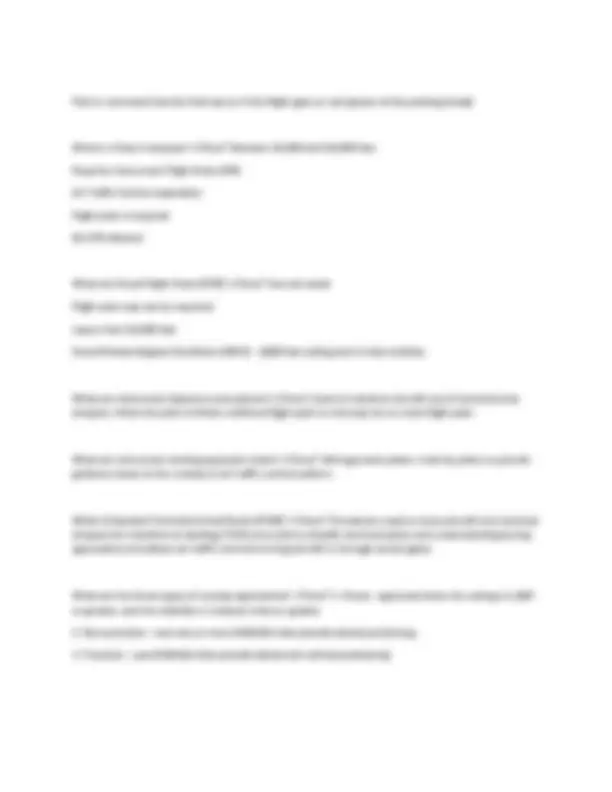












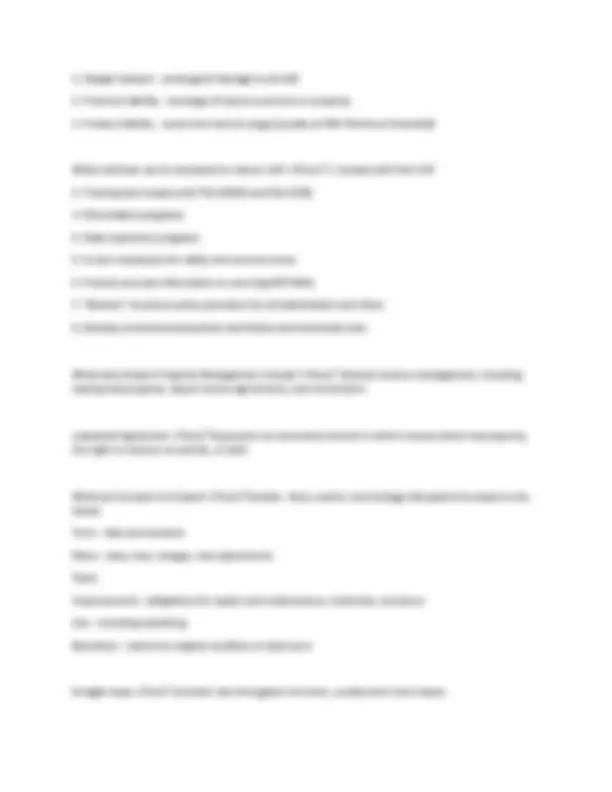







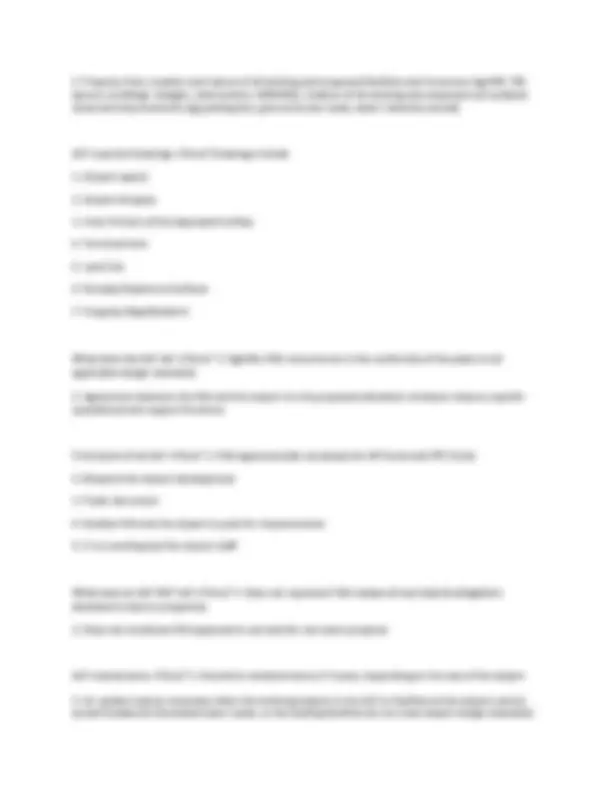










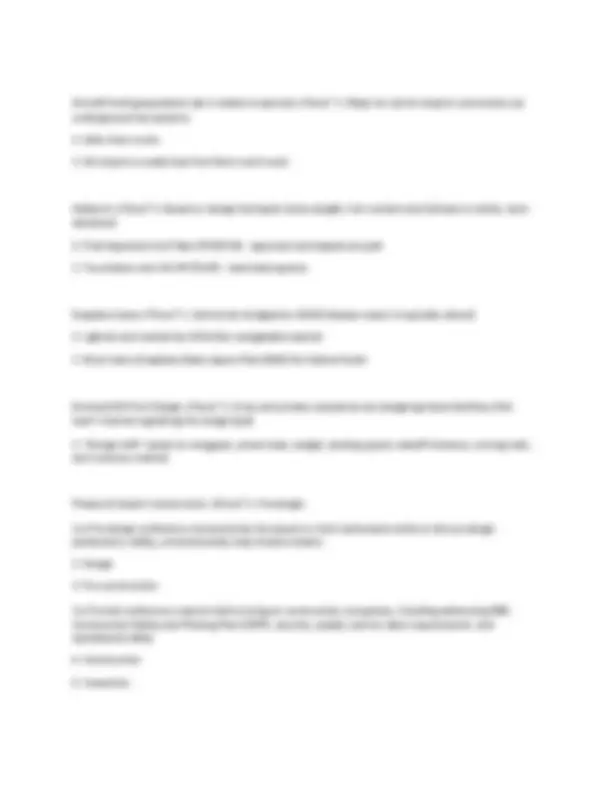
























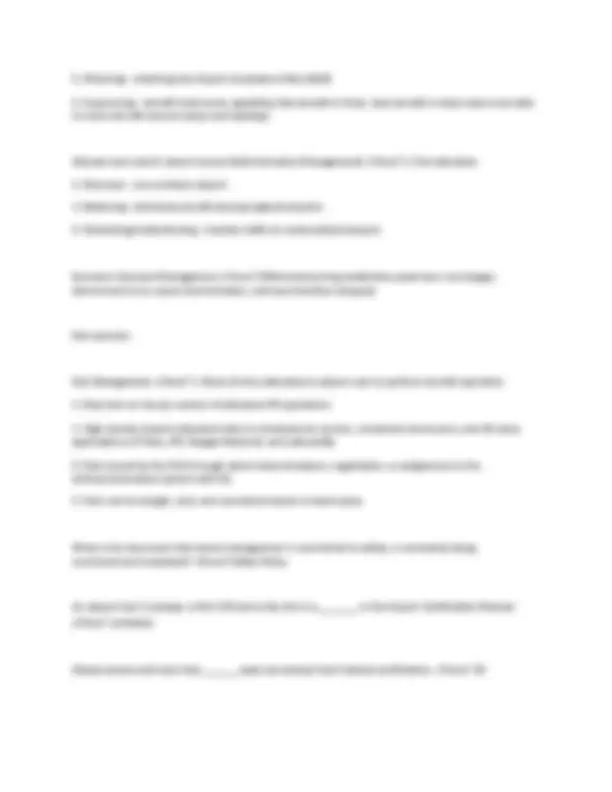























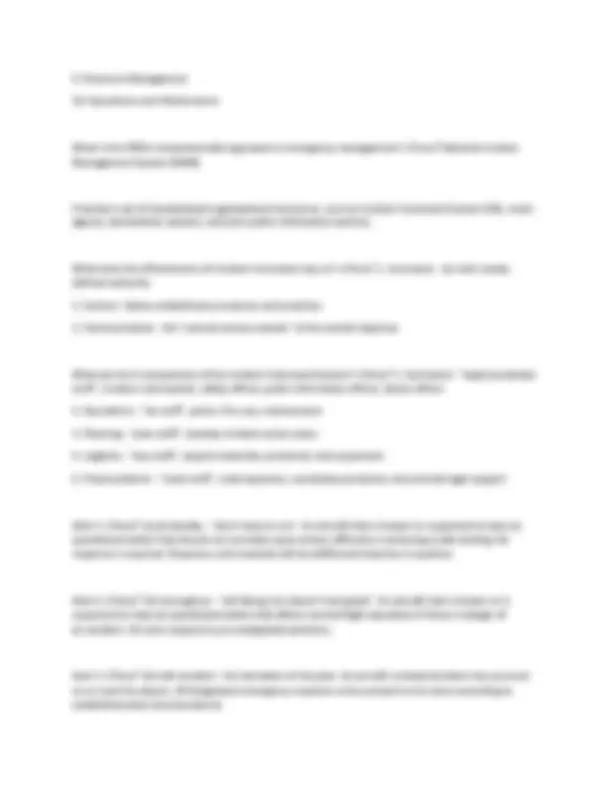

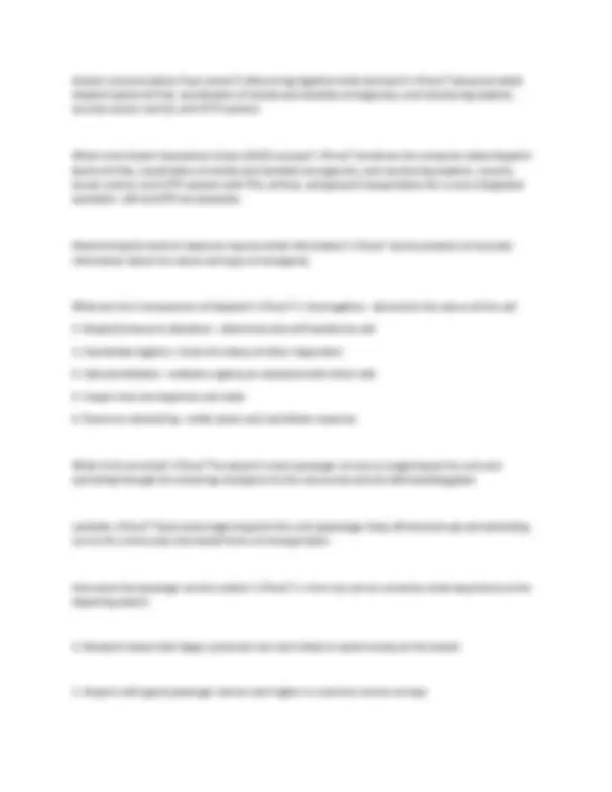

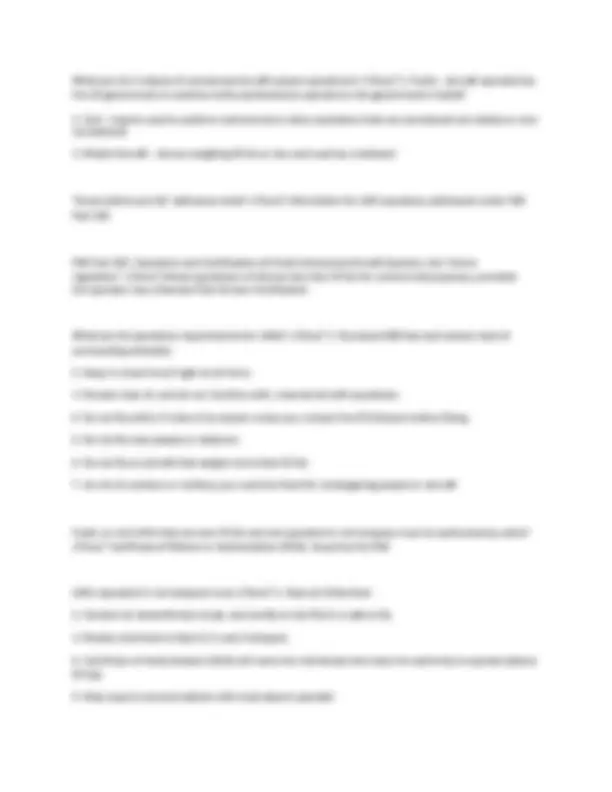



Study with the several resources on Docsity

Earn points by helping other students or get them with a premium plan


Prepare for your exams
Study with the several resources on Docsity

Earn points to download
Earn points by helping other students or get them with a premium plan
Community
Ask the community for help and clear up your study doubts
Discover the best universities in your country according to Docsity users
Free resources
Download our free guides on studying techniques, anxiety management strategies, and thesis advice from Docsity tutors
Where does TSA have regulatory influences and authority within the terminal? ✔Ans✔ 1. Checkpoint operations 2. Airport police response to checkpoints and incidents 3. Unattended bags 4. Unattended vehicles What did the Air Commerce Act (1926) prohibit? ✔Ans✔ Using federal funds to build or improve airports. Works Progress Administration (WPA) ✔Ans✔ Provided 50% of needed funding. Built over 800 new airports. Air Commerce Act of 1926 created what? ✔Ans✔ Aeronautics Branch (soon known as the Civil Aeronautics Admin) under the Dept. of Commerce. Charged with fostering air commerce, establishing air traffic control, licensing for pilots, aircraft certification, establishing airways, and issue and enforce air traffic rules
Typology: Exams
1 / 127

This page cannot be seen from the preview
Don't miss anything!





























































































Where does TSA have regulatory influences and authority within the terminal? ✔Ans✔ 1. Checkpoint operations
What are the cloud ceiling and visibility requirements for Visual Flight Rules? ✔Ans✔ Cloud ceiling: 1,000' Visibility requirements: 3 miles "1000 and 3" What is the entity who is responsible for airport governance? ✔Ans✔ The Airport Sponsor. What is the most common airport ownership type in the U.S.? ✔Ans✔ Municipalities (cities and counties) Who sets standards for security access control systems? ✔Ans✔ The Radio Technical Commission on Aeronautics How many days are required for the Notice of Proposed Rule-Making? ✔Ans✔ 30 days What is the directive to FAA personnel on specific subjects and programs? ✔Ans✔ The FAA Order What is the method the FAA has found to be the best to extend federal policy to local government units? ✔Ans✔ Grant Assurances What is 14 CFR Part 13 Investigation and Enforcement ✔Ans✔ The informal complaint system that is filed with the Airport District Office. FAA will investigate and offer to help resolve. If the sponsor is in violation, the FAA provides the opportunity to comply. A Notice of Noncompliance may be issued if the FAA believes the airport is non-compliant. The letter will identify the apparent violation(s), specifies corrective action(s), and gives a deadline. What is 14 CFR Part 16 Rules of Practice for Federally-Assisted Airport Enforcement Proceedings ✔Ans✔ The formal complaint system that is filed in Washington DC. It involves financial compliance and reasonable and nondiscriminatory access, but includes all obligations in the Grant Assurances and property deeds. Formal agency finding regarding the compliance status of an airport.
What is the benefit of grant assurances to the airport user? ✔Ans✔ Ensures adequate level of safe and effective service What are examples of non-aeronautical revenue sources? ✔Ans✔ Concessions, parking lot charges, rental cars, advertising space, industrial park Is a payment to a municipality in excess of the cost acceptable? (eg for police or fire service) ✔Ans✔ No. This is an example of a revenue diversion. What is the most common aeronautical charge at a commercial service airport? ✔Ans✔ Landing fees. Based on per operation and per weight basis; relatively small portion of an airline operating costs, yet highly contentious during negotiations. What is the FAA's position on the airport fee and rental structure for aeronautical services? ✔Ans✔ Rates and fees must be as self-sustaining as possible. What is the FAA's position on the airport fee and rental structure of non-aeronautical services? ✔Ans✔ Rates and fees should be Fair Market Value. What type of agreement between the airlines and the airport puts the airlines at the most risk? ✔Ans✔ Residual What was the Air Mail Act of 1925, also known as the Kelly Act, and what did it do? ✔Ans✔ Authorized the Postmaster General to contract for domestic airmail service with commercial air carriers Only those who use aviation would pay for it Who began the first U.S. air freight service (between Detroit and Chicago)? ✔Ans✔ Henry Ford
Who carried out most of the commercial related aviation activities before the Air Mail Act? ✔Ans✔ The US Army carried mail for the post office What is a Fixed Based Operator? ✔Ans✔ FBOs were originally fuel and rest stops for pilots. The buildings were then turned into terminals as aviation grew. What is the American Association of Airport Executives (AAAE)? ✔Ans✔ Established in 1928. First airport management trade organization. Consisted of 10 airport directors attending the National Air Races at mines Field (now LAX). Adopted first professional accreditation standards in 1954. Provides lobbying, regulatory services, training, accreditation, and other professional development programs. What was the Aeronautics Branch was reorganized and restructured into? ✔Ans✔ Civil Aeronautics Administration (CAA) under the Dept of Commerce What did the Civil Aeronautics Admin (CAA) split into, and what were the duties of each branch? ✔Ans✔ CAA maintained Air Traffic Control, Pilot and aircraft certification, Safety enforcement, and Airway development Civil Aeronautics Board (CAB) ensured safety rules, conducting aircraft accident investigations, economic regulation of the airlines, approving air routes, and regulating airfares What was the Development of Landing Areas for National Defence (DLAND) appropriation? ✔Ans✔ Secretary of War and Commerce & Secretary of the Navy could acquire land for airport development needed for the war effort. 986 airports built in the US.
Airport and Airway Improvement Act of 1982 ✔Ans✔ Created the Airport Improvement Program where 75 - 90% of a project is covered by federal money. Reorganized the National Airport Plan as the National Plan of Integrated Airport Systems (NPIAS), establishing airport categories of commercial and GA. Why was the Transportation Security Administration started? ✔Ans✔ In response to the 9/11 terrorist attacks. Vision 100 - Century of Aviation Reauthorization Act of 2003 ✔Ans✔ Endorsed Next Generation Air Transportation System (NextGen). Multi-faceted series of initiatives designed to make air travel more efficient, secure, and safer. What are the new challenges in aviation? ✔Ans✔ 1. Unmanned Aerial Vehicles (UAVs)
What three primary measurements does the FAA use on airports? ✔Ans✔ Enplanements - a passenger boarding a commercial service aircraft or transferring to another commercial service flight Operations - an aircraft taking off or landing Cargo - measured in annual tonnage moved through the airport What is hub size dependent on? ✔Ans✔ percentage of enplanements. A large hub accounts for 70% of passenger enplanements. How many enplanements are needed to be a Primary commercial service airport? ✔Ans✔ Over 10, What are the 5 types of airports in the US? ✔Ans✔ Private - no federal funds Commercial service Cargo service General Aviation and General Aviation Reliever Military What are the four types of GA Airports? ✔Ans✔ National (very high levels of activity, approx 200 based aircraft) Regional (high levels of activity, approx 90 based aircraft) Local (moderate levels of activity, approx 33 based aircraft) - "backbone" of GA Basic (low levels of activity, approx 10 based aircraft) What are the three types of military airports? ✔Ans✔ Pure military - entirely owned by DOD, and is not regulated by the FAA or TSA. Joint-Use - owned by DOD, both military and civilian aircraft share the airfield, but space is leased for the commercial service airport.
Pilot in command has the final say on if the flight goes or not (power of the parking break) Where is Class A airspace? ✔Ans✔ Between 18,000 and 60,000 feet Requires Instrument Flight Rules (IFR) Air Traffic Control separation Flight plan is required No VFR allowed What are Visual Flight Rules (VFR)? ✔Ans✔ See and avoid Flight plan may not be required Lower than 18,000 feet Visual Meteorological Conditions (VMC) - 1000 feet ceiling and 3 miles visibility What are instrument departure procedures? ✔Ans✔ Used to transition aircraft out of terminal area airspace. Allow the pilot to follow a defined flight path to intercept an en route flight path. What are instrument landing approach charts? ✔Ans✔ AKA approach plates. Used by pilots to provide guidance down to the runway or air traffic control pattern. What is Standard Terminal Arrival Route (STAR)? ✔Ans✔ Procedures used to move aircraft into terminal airspace for transition to landing; STARs are used to simplify communication and understanding during approaches and allows air traffic control to bring aircraft in through arrival gates. What are the three types of runway approaches? ✔Ans✔ 1. Visual - approved when the ceiling is 1,000' or greater, and the visibility is 3 statute miles or greater
What is an instrument approach plate? ✔Ans✔ AKA approach chart. A published flight path that ensures clearance over obstacles, sets minimum descent altitudes, and includes procedures for a missed approach. What are the two primary obligations of airport operators? ✔Ans✔ 1. Responsibility to the FAA to operate the airport as an essential component of the national aviation system.
What are FAA's major roles? ✔Ans✔ 1. regulating civil aviation to promote safety.
What two documents does the TSA put out? ✔Ans✔ Security Directives - "have to", provide direction to change security requirements Information Circulars - "don't have to", provide best practices and other information What are Grant Assurances? ✔Ans✔ Promises the sponsor makes when it accepts federal money. Trace back to the AP-4 agreements, the Surplus Property Act, commitments in environmental documents, or litigation. Effective means for the FAA to extend federal policy to local governmental units. Balance three public interests: better manage local affairs, meet FAA requirements that money is spent for public air transportation, and they promote social objectives (eg DBE). Good for 20 years, life (if property), or life of an asset. Managed through the Airport Compliance Manual. Risk losing federal funds by being placed on the Airport Noncompliance list if the airport doesn't adhere to them. Grant Assurances essentially cover what? ✔Ans✔ 1. Maintain the airport in good and serviceable condition.
National Business Aviation Association (NBAA) ✔Ans✔ Represents companies who rely on general aviation aircraft to help make their businesses more efficient, productive, and successful; 11, members. Aircraft Owners and Pilots Association (AOPA) ✔Ans✔ Non-profit organization dedicated to GA pilots and aircraft owners. Notable programs are Airport Watch and Airport Support Network. National Air Transportation Association (NATA) ✔Ans✔ Represents aviation businesses such as FBOs, Specialized Aviation Service Operators (SASO), and other provider Aerospace Industries Association (AIA) ✔Ans✔ Represents manufacturers and suppliers of civil, military, and business aircraft, helicopters, unmanned aerial systems, space systems, and aircraft engines, as well as provides security detection technology at airports. National Association of State Aviation Officials (NASAO) ✔Ans✔ Represents employees of state government aviation agencies. National Air Traffic Controllers Association (NATCA) ✔Ans✔ Represents over 20,000 controllers, engineers, and other safety-related professionals at FAA, DOD, and some privately-contracted air traffic control facilities Helicpoter Association International (HAI) ✔Ans✔ Provides support and advocacy to helicopter operators Airport operators must remember what two concepts? ✔Ans✔ They are running a public entity that is also a business entity (that is heavily regulated by the FAA, TSA, and EPA) What are the two types of airport land? ✔Ans✔ On-airport and off-airport What are the two types of on-airport land? ✔Ans✔ Aeronautical and non-aeronautical. The FAA must give permission to reclassify aero land as non-aero.
Grant Assurance #20, Hazard Removal and Mitigation ✔Ans✔ Requires the airport to protect the airspace around the airport, including approach paths The airport must attempt to reduce or eliminate incompatible land through what methods? ✔Ans✔ 1. Airport Master Plans - integration with local zoning and community plans
Through the fence ✔Ans✔ FAA generally believes a Through the fence agreement denies an airport's rights and powers (Grant Assurance #5). Strongly prohibited They are not subject to Minimum Standards What are the 3 types of airport revenue? ✔Ans✔ Aeronautical - services related directly and substantially to the movement of passengers, baggage, mail, and cargo. Non-aeronautical - services related to those operations and uses that are incidental to the operation of aircraft. Non-operating - relates to taxes on personal property or possessory interest, grant monies, Passenger Facility Charges (PFC) and Customer Facility Charges (CFC) Fuel Flowage fee ✔Ans✔ Airport charges a percentage on the amount of fuel pumped at the airport, including self-fueling operations Land Lease and Terminal Rent Agreements for Aeronautical Use Space ✔Ans✔ Hangar and terminal space leasing and leasing land for aero development (eg ticket counter, baggage claim areas) Non-aeronautical revenue sources ✔Ans✔ Terminal rents to concessions, rental car fees, parking lot charges, advertising space, industrial park 2 ways a community benefits from having an airport? ✔Ans✔ 1. Economic benefits from new money that comes into the community via air.
substantially relate to the actual air transportation of passengers or the property or noise mitigation efforts. What are 8 ways of diverting revenue? ✔Ans✔ 1. General economic development for the municipality, or using fees or airport land/resources to benefit the community